Potrebujeme váš súhlas na využitie jednotlivých dát, aby sa vám okrem iného mohli ukazovať informácie týkajúce sa vašich záujmov. Súhlas udelíte kliknutím na tlačidlo „OK“.
ASTM D7615/D7615M-11
Standard Practice for Open-Hole Fatigue Response of Polymer Matrix Composite Laminates
Automaticky preložený názov:
Štandardné praktiky pre Open-diery únavovej reakcie polymérnej matrice kompozitné lamináty
NORMA vydaná dňa 1.1.2011
Informácie o norme:
Označenie normy: ASTM D7615/D7615M-11
Poznámka: NEPLATNÁ
Dátum vydania normy: 1.1.2011
Kód tovaru: NS-38832
Počet strán: 8
Približná hmotnosť: 24 g (0.05 libier)
Krajina: Americká technická norma
Kategória: Technické normy ASTM
Kategórie - podobné normy:
Anotácia textu normy ASTM D7615/D7615M-11 :
Keywords:
composite materials, compression testing, fatigue, tension testing, ICS Number Code 83.120 (Reinforced plastics)
Doplňujúce informácie
| Significance and Use | ||||||||||||||||||||||||||||||||
|
This practice provides supplemental instructions for using Test Methods D5766/D5766M or D6484/D6484M to obtain open-hole fatigue data for material specifications, research and development, material design allowables, and quality assurance. The primary property that results is the fatigue life of the test specimen under a specific loading and environmental condition. Replicate tests may be used to obtain a distribution of fatigue life for specific material types, laminate stacking sequences, environments, and loading conditions. Guidance in statistical analysis of fatigue data, such as determination of linearized stress life (S-N) curves, can be found in Practice E739. This practice can be utilized in the study of fatigue damage in a polymer matrix composite open-hole specimen such as the occurrence of microscopic cracks, fiber fractures, or delaminations. The change in strength associated with fatigue damage may be determined by discontinuing cyclic loading to obtain the static strength using Test Methods D5766/D5766M or D6484/D6484M. Note 2—This practice may be used as a guide to conduct variable amplitude loading. This information can be useful in the understanding of fatigue behavior of composite structures under spectrum loading conditions, but is not covered in this standard. Factors that influence open-hole fatigue response and shall therefore be reported include the following: material, methods of material fabrication, accuracy of lay-up, laminate stacking sequence and overall thickness, specimen geometry, specimen preparation (especially of the hole), specimen conditioning, environment of testing, type of support fixture, specimen alignment and gripping, test frequency, force (stress) ratio, normal stress magnitude, void content, and volume percent reinforcement. Properties that result include the following: Specimen stiffness versus fatigue life curves for selected normal stress values. Normal stress versus specimen stiffness curves at selected cyclic intervals. Normal stress versus fatigue life curves for selected stress ratio values. |
||||||||||||||||||||||||||||||||
| 1. Scope | ||||||||||||||||||||||||||||||||
|
1.1 This practice provides instructions for modifying static open-hole tensile and compressive strength test methods to determine the fatigue behavior of composite materials subjected to cyclic tensile or compressive forces, or both. The composite material forms are limited to continuous-fiber reinforced polymer matrix composites in which the laminate is both symmetric and balanced with respect to the test direction. The range of acceptable test laminates and thicknesses are described in 8.2. 1.2 This practice supplements Test Methods D5766/D5766M and D6484/D6484M with provisions for testing specimens under cyclic loading. Several important test specimen parameters (for example, fatigue force(stress) ratio) are not mandated by this practice; however, repeatable results require that these parameters be specified and reported. 1.3 This practice is limited to test specimens subjected to constant amplitude uniaxial loading, where the machine is controlled so that the test specimen is subjected to repetitive constant amplitude force (stress) cycles. Either engineering stress or applied force may be used as a constant amplitude fatigue variable. The repetitive loadings may be tensile, compressive, or reversed, depending upon the test specimen and procedure utilized. 1.4 The values stated in either SI units or inch-pound units are to be regarded separately as standard. The values stated in each system may not be exact equivalents; therefore, each system shall be used independently of the other. Combining values from the two systems may result in non-conformance with the standard. 1.4.1 Within the text the inch-pound units are shown in brackets. 1.5 This standard does not purport to address all of the safety concerns, if any, associated with its use. It is the responsibility of the user of this standard to establish appropriate safety and health practices and determine the applicability of regulatory limitations prior to use. |
||||||||||||||||||||||||||||||||
| 2. Referenced Documents | ||||||||||||||||||||||||||||||||
|
Podobné normy:
Historická
1.3.2008
Historická
15.4.2009
Historická
1.3.2014
Historická
1.2.2011
Historická
15.11.2013
Historická
1.9.2007


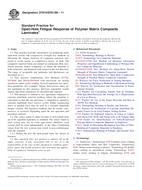
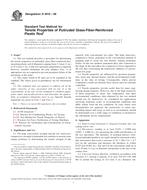 ASTM D3916-08
ASTM D3916-08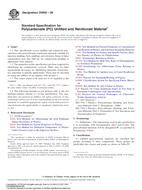 ASTM D3935-09
ASTM D3935-09 ASTM D3982-08(2014)..
ASTM D3982-08(2014)..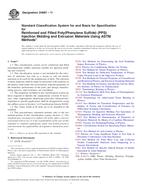 ASTM D4067-11
ASTM D4067-11 ASTM D4385-13
ASTM D4385-13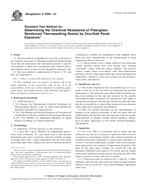 ASTM D4398-07
ASTM D4398-07
 Cookies
Cookies
